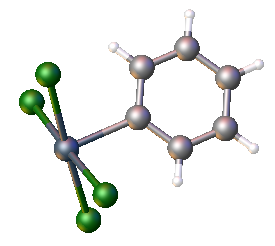|
Tellurol
Tellurols are analogues of alcohol (chemistry), alcohols and phenols where tellurium replaces oxygen. Tellurols, selenols, and thiols have similar properties, but tellurols are the least stable. Although they are fundamental representatives of organotellurium compounds, tellurols are lightly studied because of their instability. Tellurol derivatives include telluroesters (RC(O)TeR') and tellurocyanates (RTeCN). Properties Alkyltellurols are colorless liquids with strong odors. Samples usually appear yellowish owing to the presence of dialkylditelluride impurities. Near room temperature, methanetellurol degrades with loss of elemental tellurium. It is reported to ignite in air. Aryltellurols are more robust and have been obtained as colorless crystals. Some of the most stable tellurols are the bulky silylated derivatives of tris(trimethylsilyl)methane and analogues. One series of readily isolable tellurols is , , and . Acid–base properties The acidity of tellurols can be infer ... [...More Info...] [...Related Items...] OR: [Wikipedia] [Google] [Baidu] |
Methanetellurol
Methanetellurol is the organotellurium compound with the formula . It is the simplest organotellurium compound that has been purified in bulk. It is classified as a tellurol. A colorless gas, it decomposes to Te and methane near room temperature. It is prepared by reduction of dimethyl ditelluride using Sodium, Na/Ammonia, followed by protonation of the (sodium methanetellurolate) with sulfuric acid. Few publications describe this compound as a consequence of its instability and paucity of applications. According to IR spectroscopy, νTe-H = 1995 cm−1. For the lighter Homologous series, homologues, νE-H = 2342 (E = Se), 2606 (E = S), and 3710 cm−1 (E = O) for methaneselenol, methanethiol, and methanol.{{cite journal , doi=10.1080/00945717708069709, title=The Synthesis and the Raman and Infrared Spectra of Methanetellurol, year=1977, last1=Hamada, first1=K., last2=Morishita, first2=H., journal=Synthesis and Reactivity in Inorganic and Metal-Organic Chemistry, volume= ... [...More Info...] [...Related Items...] OR: [Wikipedia] [Google] [Baidu] |
Tellurium
Tellurium is a chemical element; it has symbol Te and atomic number 52. It is a brittle, mildly toxic, rare, silver-white metalloid. Tellurium is chemically related to selenium and sulfur, all three of which are chalcogens. It is occasionally found in its native form as elemental crystals. Tellurium is far more common in the Universe as a whole than on Earth. Its extreme rarity in the Earth's crust, comparable to that of platinum, is due partly to its formation of a volatile hydride that caused tellurium to be lost to space as a gas during the hot nebular formation of Earth. Tellurium-bearing compounds were first discovered in 1782 in a gold mine in Kleinschlatten, Transylvania (now Zlatna, Romania) by Austrian mineralogist Franz-Joseph Müller von Reichenstein, although it was Martin Heinrich Klaproth who named the new element in 1798 after the Latin 'earth'. Gold telluride minerals are the most notable natural gold compounds. However, they are not a commercially signif ... [...More Info...] [...Related Items...] OR: [Wikipedia] [Google] [Baidu] |
Tris(trimethylsilyl)methane
Tris(trimethylsilyl)methane is the organosilicon compound with the formula (tms)3CH (where tms = (CH3)3Si). It is a colorless liquid that is highly soluble in hydrocarbon solvents. Trisyl chemistry Reaction of tris(trimethylsilyl)methane with methyl lithium gives tris(trimethylsilyl)methyllithium, called trisyllithium: :(tms)3CH + CH3Li → (tms)3CLi + CH4 Trisyllithium is useful in Petersen olefination reactions: :(tms)3CLi + R2CO → (tms)2C=CR2 + tmsOLi Trisyllithium is also a source of the bulky trisyl ligand. Some tris(trimethylsilyl)methyl derivatives are far more stable than less substituted derivatives. For example, is a well-behaved tellurol Tellurols are analogues of alcohol (chemistry), alcohols and phenols where tellurium replaces oxygen. Tellurols, selenols, and thiols have similar properties, but tellurols are the least stable. Although they are fundamental representatives of orga .... is a rare example of a robust organothallium(I) compou ... [...More Info...] [...Related Items...] OR: [Wikipedia] [Google] [Baidu] |
Hydrogen Telluride
Hydrogen telluride is the inorganic compound with the formula H2 Te. A hydrogen chalcogenide and the simplest hydride of tellurium, it is a colorless gas. Although unstable in ambient air, the gas can exist long enough to be readily detected by the odour of rotting garlic at extremely low concentrations; or by the revolting odour of rotting leeks at somewhat higher concentrations. Most compounds with Te–H bonds (tellurols) are unstable with respect to loss of H2. H2Te is chemically and structurally similar to hydrogen selenide, both are acidic. The H–Te–H angle is about 90°. Volatile tellurium compounds often have unpleasant odours, reminiscent of decayed leeks or garlic.Greenwood, N. N.; & Earnshaw, A. (1997). Chemistry of the Elements (2nd Edn.), Oxford:Butterworth-Heinemann. . Synthesis Electrolytic methods have been developed.F. Fehér, "Hydrogen Telluride" in Handbook of Preparative Inorganic Chemistry, 2nd Ed. Edited by G. Brauer, Academic Press, 1963, NY. Vol. 1. ... [...More Info...] [...Related Items...] OR: [Wikipedia] [Google] [Baidu] |
Alcohol (chemistry)
In chemistry, an alcohol (), is a type of organic compound that carries at least one hydroxyl () functional group bound to a Saturated and unsaturated compounds, saturated carbon atom. Alcohols range from the simple, like methanol and ethanol, to complex, like sugar alcohols and cholesterol. The presence of an OH group strongly modifies the properties of Hydrocarbon, hydrocarbons, conferring Hydrophile, hydrophilic (water-loving) properties. The OH group provides a site at which many reactions can occur. History The flammable nature of the exhalations of wine was already known to ancient natural philosophers such as Aristotle (384–322 BCE), Theophrastus (–287 BCE), and Pliny the Elder (23/24–79 CE). However, this did not immediately lead to the isolation of alcohol, even despite the development of more advanced distillation techniques in second- and third-century Roman Egypt. An important recognition, first found in one of the writings attributed to Jabir ibn Hayyan, J� ... [...More Info...] [...Related Items...] OR: [Wikipedia] [Google] [Baidu] |
Phenol
Phenol (also known as carbolic acid, phenolic acid, or benzenol) is an aromatic organic compound with the molecular formula . It is a white crystalline solid that is volatile and can catch fire. The molecule consists of a phenyl group () bonded to a hydroxy group (). Mildly acidic, it requires careful handling because it can cause chemical burns. It is acutely toxic and is considered a health hazard. Phenol was first extracted from coal tar, but today is produced on a large scale (about 7 million tonnes a year) from petroleum-derived feedstocks. It is an important industrial commodity as a precursor to many materials and useful compounds, and is a liquid when manufactured. It is primarily used to synthesize plastics and related materials. Phenol and its chemical derivatives are essential for production of polycarbonates, epoxies, explosives such as picric acid, Bakelite, nylon, detergents, herbicides such as phenoxy herbicides, and numerous pharmaceuti ... [...More Info...] [...Related Items...] OR: [Wikipedia] [Google] [Baidu] |
Russian Chemical Reviews
The ''Russian Chemical Reviews'' journal was founded in 1932 and is currently published by the N. D. Zelinsky Institute of Organic Chemistry of the Russian Academy of Sciences. The journal publishes high-quality authoritative and critical reviews on topical issues of modern chemistry and related sciences According to the ''Journal Citation Reports'', the journal has a 2023 impact factor of 7.0. In 2022, the journal moved to an open access publishing model. It has since become a diamond open access Diamond open access refers to academic texts (such as monographs, edited collections, and journal articles) published/distributed/preserved with no fees to either reader or author. Alternative labels include platinum open access, non-commercial o ... journal, with no charges to readers or authors. References Monthly journals Russian Academy of Sciences academic journals {{chemistry-journal-stub ... [...More Info...] [...Related Items...] OR: [Wikipedia] [Google] [Baidu] |
Selenol
Selenols are organic compounds that contain the functional group with the connectivity . Selenols are sometimes also called selenomercaptans and selenothiols. Selenols are one of the principal classes of organoselenium compounds. A well-known selenol is the amino acid selenocysteine. Structure and properties Selenols are structurally similar to thiols, but the bond is about 8% longer at 196 pm. The angle approaches 90°. The bonding involves almost pure p-orbitals on Se, hence the near 90 angles. The bond energy is weaker than the bond, consequently selenols are easily oxidized and serve as H-atom donors. The Se-H bond is weaker than the bond as reflected in their respective bond dissociation energy (BDE). For , the BDE is 326 kJ/mol, while for , the BDE is 368 kJ/mol. Selenols are about 1000 times stronger acids than thiols: the p''K''a of is 5.2 vs 8.3 for . Deprotonation affords the selenolate anion, , most examples of which are highly nucleophilic and rapidly o ... [...More Info...] [...Related Items...] OR: [Wikipedia] [Google] [Baidu] |
Thiol
In organic chemistry, a thiol (; ), or thiol derivative, is any organosulfur compound of the form , where R represents an alkyl or other organic substituent. The functional group itself is referred to as either a thiol group or a sulfhydryl group, or a sulfanyl group. Thiols are the sulfur analogue of alcohols (that is, sulfur takes the place of oxygen in the hydroxyl () group of an alcohol), and the word is a blend of "''thio-''" with "alcohol". Many thiols have strong odors resembling that of garlic, cabbage or rotten eggs. Thiols are used as odorants to assist in the detection of natural gas (which in pure form is odorless), and the smell of natural gas is due to the smell of the thiol used as the odorant. Nomenclature Thiols are sometimes referred to as mercaptans () or mercapto compounds, a term introduced in 1832 by William Christopher Zeise and is derived from the Latin ('capturing mercury')''Oxford American Dictionaries'' (Mac OS X Leopard). because the thiolate grou ... [...More Info...] [...Related Items...] OR: [Wikipedia] [Google] [Baidu] |
Inorganic Chemistry (journal)
''Inorganic Chemistry'' is a biweekly peer-reviewed scientific journal published by the American Chemical Society since 1962. It covers research in all areas of inorganic chemistry. The current editor-in-chief is Stefanie Dehnen ( Karlsruhe Institute of Technology). Abstracting and indexing The journal is abstracted and indexed in: According to the ''Journal Citation Reports'', the journal has a 2022 impact factor The impact factor (IF) or journal impact factor (JIF) of an academic journal is a type of journal ranking. Journals with higher impact factor values are considered more prestigious or important within their field. The Impact Factor of a journa ... of 4.6. See also * '' Organometallics'' References External links * American Chemical Society academic journals Biweekly journals Academic journals established in 1962 English-language journals Inorganic chemistry journals {{chem-journal-stub ... [...More Info...] [...Related Items...] OR: [Wikipedia] [Google] [Baidu] |
Organotellurium Compound
Organotellurium chemistry describes the synthesis and properties of organotellurium compounds, chemical compounds containing a carbon-tellurium chemical bond. Organotellurium chemistry is a lightly studied area, in part because of it having few applications. Functional groups The tellurium analogues of common organosulfur and organoselenium functional groups are known. Tellurols are however unstable with respect to oxidation to the ditellurides. Commonly encountered organotellurium compounds are diorganomono- and ditellurides, R2Te and (RTe)2, respectively. Two other families of organotellurium(IV) compounds are well developed: R4−xTeClx and the telluroxides (R2TeO). Synthesis and reactions Reduced organotellurium compounds Reduced organotellurium compounds are commonly obtained from NaHTe and lithium telluride: :Li2Te + 2 RBr → R2Te + 2 LiBr A direct route to organolithium compounds starts from reactions of organolithium or Grignard reagents and Te: :Te + ArLi � ... [...More Info...] [...Related Items...] OR: [Wikipedia] [Google] [Baidu] |





